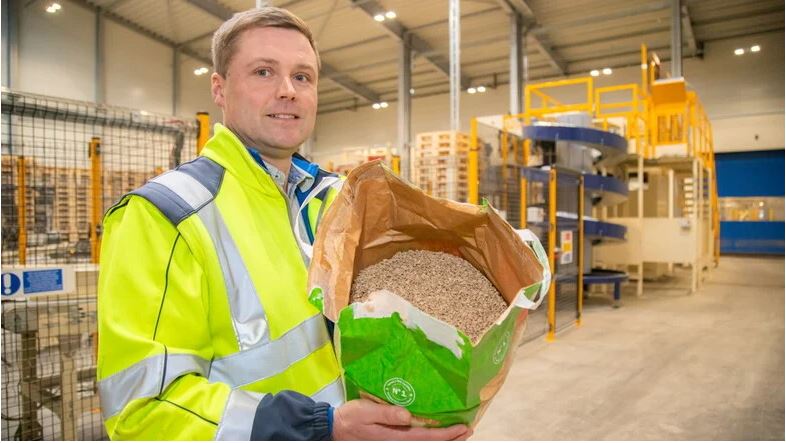From Steffen Gerhardt
Over the past three years, a completely new plant has been built at the entrance to Rothenburg airfield. Natural fiber fabrics Rothenburg is the name of the company. That might not mean much even to cat lovers, although an important product for the "house tigers" is manufactured between Rothenburg and Lodenau: cat litter.
The special thing about it is that this litter is 100 percent natural, on which the cat does its business. Plant manager Marcus Schymura emphasizes that this litter is a pure wood product. A tree trunk is processed in the factory so that the end result is fine, dry litter in a paper bag that literally encapsulates the cat's urine and can be disposed of as a lump. "This litter is sold under the name Cat's Best sold throughout Europe. In Germany, it is available in drugstores and DIY stores," adds the plant manager.
Natural fiber for animal feed
Litter is one product line that is used at the airport. The second is an additive for the production of animal feed. This additive is also obtained solely from wood. In the end, it is a granulate that is delivered to the animal feed manufacturers for further processing. It contains cellulose-based fiber. Distribution is global, as Marcus Schymura emphasizes. "Our products based on natural and renewable raw materials remain part of a natural cycle, even though they undergo extensive processing," says the plant manager. Various certifications confirm this.
This starts with the raw materials. The wood from the forest and the sawdust from the wood processing industry must already have an ecological seal, otherwise it will not be processed. So if you have a pile of sawdust at home from making wood, you can't offer it for sale. "We have fixed contracts with suppliers who comply with the required standard," emphasizes the plant manager.
And the demand is high. This year, at least 32,000 tons of sawdust and logs are to be processed into litter and feed additives. With this amount of wood, the production capacities are well utilized. And this is done according to ecological standards. The supply chain law now being discussed in the EU is already a reality at the company. "We can precisely trace the history of our two products from the felled tree to the packaging," says Marcus Schymura.
A dozen articulated trucks drive to the plant every day. They bring wood or sawdust or collect the two products ready packed. Two articulated lorries with new wooden pallets arrive every week. The only access road is the S 127 along the Neisse. Marcus Schymura is familiar with the Nieder Neundorf bottleneck. "That's why I'm also in favor of the bypass finally being built."
Restart at zero
As the company grew, the now 42-year-old was first appointed Head of Production and Technology and more recently Plant Manager. The trained craftsman lives with his family in Lodenau, in the immediate vicinity. The natural fibers were created on the site of "Eko Energy", which went bankrupt in 2018, a manufacturer of wood pellets. "The company was running on wear and tear, there were no paved roads on the factory premises, we practically started from scratch," Marcus Schymura remembers the difficult start.
New halls, silos, production facilities, a social wing and extinguishing ponds were built and installed. The most recent achievement is a storage hall for sawdust covering an area of 4,000 square meters. Space like a small soccer pitch. This is necessary to protect the raw material from environmental influences. After all, the sawdust is turned into food for animals, which humans end up eating.

Two new warehouses
A large warehouse was also built on an area of 3,500 square meters, where the pallet goods await dispatch. Everything is controlled by computer. If the forklift driver picks up the wrong pallet, he is informed at the warehouse exit at the latest that he does not have the right goods on his fork. Many processes run automatically, so that humans are mainly responsible for checking, loading the machines with packaging material and maintenance.
This is reflected in the small number of employees. The plant has 31 employees, who work in three shifts from Monday to Saturday morning. The professions needed here range from machine and plant operators to fitters and electricians. A new employee is still being sought for the latter profession. Power plant operators are also employed on the 18-hectare site. A wood chip-based combined heat and power plant not only dries the raw material, but also generates energy and heats rooms and halls.
The company is also looking into securing its power supply via its own power plant and thus becoming independent of the public power grid. "We have not yet reached the end of our investments. There's a lot more to come in the next few years," explains Marcus Schymura. The extension of the outbuilding of the former heating plant for the airfield is now underway. It is to be converted into our own workshop.








